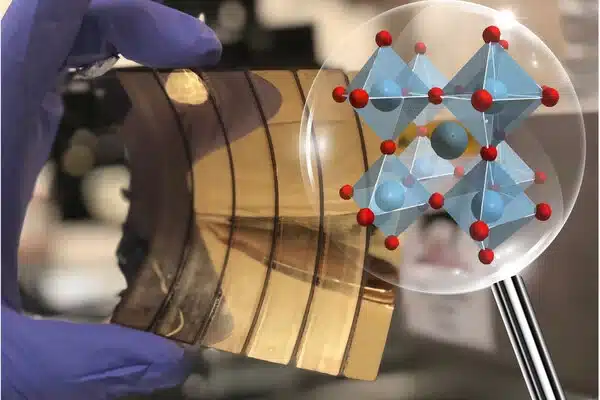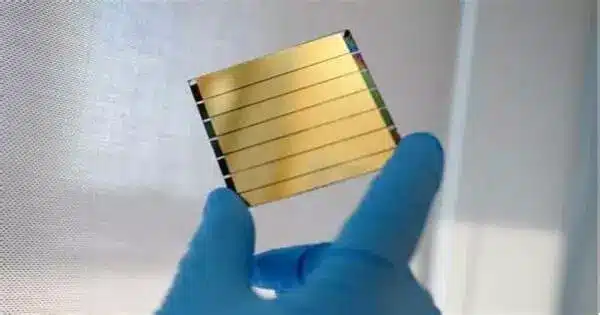Because of their rapid improvements in efficiency and affordability, perovskite solar cells have received a lot of attention in the field of photovoltaics. They are made from a class of materials known as perovskites, which are relatively easy to synthesize and have excellent photovoltaic properties.
Perovskite solar cells have now achieved an extremely high efficiency rate of 24.35% with a 1 cm2 active area. This game-changing achievement in maximizing power generation from next-generation renewable energy sources will be critical in securing the world’s energy future.
A team of scientists from the National University of Singapore (NUS) designed perovskite solar cells that achieved a world record efficiency of 24.35% with an active area of 1 cm2. This accomplishment paves the way for cheaper, more efficient, and long-lasting solar cells.
To allow for consistent comparisons and benchmarking of different solar cell technologies, the photovoltaic (PV) community uses a standard size of at least 1 cm2 to report the efficiency of one-sun solar cells in the “Solar Cell Efficiency Tables.” Prior to the NUS team’s record-breaking achievement, the best 1-cm2 perovskite solar cell had a power conversion efficiency of 23.7%. This game-changing achievement in maximizing power generation from next-generation renewable energy sources will be critical in securing the world’s energy future.
This work represents the first instance of an inverted-structure perovskite solar cell exceeding the normal structured perovskite solar cells with an active area of 1 cm2, and this is primarily attributed to the innovative charge transporting material incorporated in our perovskite solar cells.
Hou Yi
Perovskites are a class of materials that exhibit high light absorption efficiency and ease of fabrication, making them promising for solar cell applications. In the past decade, perovskite solar cell technology has achieved several breakthroughs, and the technology continues to evolve.
“To meet this challenge, we embarked on a focused effort to develop innovative and scalable technologies aimed at increasing the efficiency of 1-cm2 perovskite solar cells. Our goal was to bridge the efficiency gap and unlock the full potential of larger-sized devices,” said Assistant Professor Hou Yi, leader of the NUS research team, which included scientists from the NUS College of Design and Engineering’s Department of Chemical and Biomolecular Engineering as well as the Solar Energy Research Institute of Singapore (SERIS), a university-level research institute at NUS.
“This work represents the first instance of an inverted-structure perovskite solar cell exceeding the normal structured perovskite solar cells with an active area of 1 cm2, and this is primarily attributed to the innovative charge transporting material incorporated in our perovskite solar cells,” he added. Because inverted-structure perovskite solar cells have always demonstrated excellent stability and scalability, achieving higher efficiency than normal-structured perovskite cells represents a significant step forward in commercializing this cutting-edge technology.”
This milestone achievement by Asst Prof Hou Yi and his team has been included in the Solar Cell Efficiency Tables (Version 62) in 2023. Published by scientific journal Progress in Photovoltaics on 21 June 2023, these consolidated tables show an extensive listing of the highest independently confirmed efficiencies for solar cells and modules.

Low-cost, efficient and stable solar cell technology
The world record was set by successfully incorporating a novel interface material into perovskite solar cells.
“The introduction of this novel interface material results in a number of advantageous properties, including excellent optical, electrical, and chemical properties.” These properties work together to improve the efficiency and longevity of perovskite solar cells, paving the way for significant improvements in their performance and durability,” said team member Dr Li Jia, a postdoctoral researcher at SERIS.
The promising results reported by the NUS team mark a pivotal milestone in advancing the commercialisation of a low-cost, efficient, stable perovskite solar cell technology. “Our findings set the stage for the accelerated commercialisation and integration of solar cells into various energy systems. We are excited by the prospects of our invention that represents a major contribution to a sustainable and renewable energy future,” said team member Mr Wang Xi, an NUS doctoral student.
Towards a greener future
Building upon this exciting development, Asst Prof Hou and his team aim to push the boundaries of perovskite solar cell technology even further.
Another important area of focus is improving the stability of perovskite solar cells, which are sensitive to moisture and can degrade over time. “We are developing a customized accelerating aging methodology to bring this technology from the lab to the fab,” said Asst Prof Hou. One of our next objectives is to provide perovskite solar cells with a 25-year operational stability.”
The team is also working on expanding the dimensions of the perovskite solar cells and demonstrating their viability and effectiveness on a larger scale in order to scale up the solar cells to modules.
“The insights gained from our current study will serve as a roadmap for developing stable, and eventually, commercially-viable perovskite solar cell products that can serve as sustainable energy solutions to help reduce our reliance on fossil fuels,” Asst Prof Hou added.















